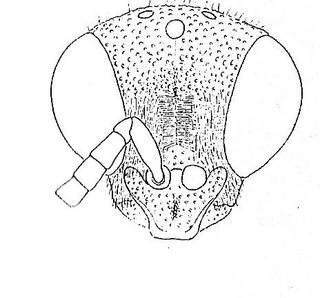
R. M. Bohart L. S. Kimsey, 1982 · 1
Chrysis lauta, head |

Click on map for details about points.
|
80x5 -
240x3 -
240x4 -
320x1 -
320x2 -
320x3 -
640x1 -
640x2
Set display option above.
Click on
images to enlarge. |
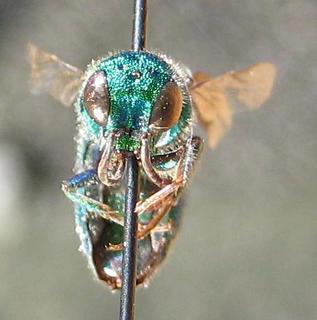
Native Bee Inventory and Monitoring Lab; Photographer: Erika Tucker · 1
Chrysis lauta, face |
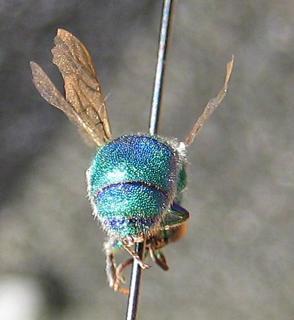
Native Bee Inventory and Monitoring Lab; Photographer: Erika Tucker · 1
Chrysis lauta, tail |
|
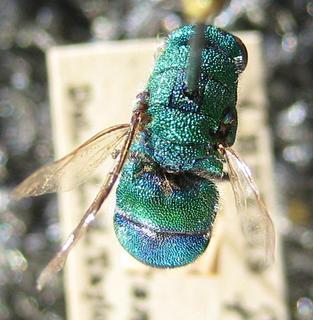
Native Bee Inventory and Monitoring Lab; Photographer: Erika Tucker · 1
Chrysis lauta, top view |
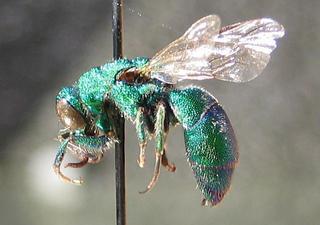
Native Bee Inventory and Monitoring Lab; Photographer: Erika Tucker · 1
Chrysis lauta |
|
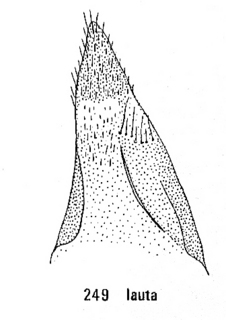
R. M. Bohart and L. S. Kimsey · 1
Chrysis lauta, male genitalia |
|
Overview |
Taken from:
R. M. Bohart and L. S. Kimsey. 1982. A Synopsis of the Chrysididae in America North of Mexico.
Chrysis lauta Cresson
(Figs. 198, 249)
Chrysis lauta Cresson 1865:311. Holotype female, Boulder, Colorado (ANSP)
Chrysis prasinus Cresson 1865:310. Holotype male (not female), Colorado (ASNP). Nec prasina Klug 1845.
Chrysis chlorophana Mocsary 1887:16. New name for prasinus Cresson.
Chrysis clypeata Mocsary 1889:393. Holotype male, Chapultepec, Mexico (Vienna).
Chrysis falsifica Buysson 1891 :38. New name for prasinus Cresson.
Discussion: Most characteristic of lauta is the long subantennal distance of at least 2.0 MOD (fig. 198) in contrast to the moderate malar space (about 1.6 MOD). The lower frons in the male is densely silvery and as broad as lengths of F-I-II-III together. It is the largest species of the group with modal body length 8. 5-9. 5 mm. Male genitalia are distinctive. The paramere is simple in outline but has a striking pattern (fig. 249). Both digitus and cuspis are moderately slender.
Material examined: 48 males including types of prasinus and clypeata, 46 females including type of lauta.
Distribution: east of the 110th meridian in WYOMING: Glendo; COLORADO: Fort Collins, Prowers Co.; NEW MEXICO and ARIZONA: Willcox. More eastern states are Nebraska, Kansas, Texas, Mississippi, Georgia, North Carolina and South Carolina. To the south the range extends through the Mexican inland from Chihuahua to Durango, Zacatecas, San Luis Potosi, Morelos, Guerrero, and Oaxaca.
Species group of Chrysis lauta Cresson
Diagnosis: Male F-I longer than or rarely equal to (vagabunda) F-III, 1.3-2.0 times as long as broad, female F-I 1.5-2.2 times; subantennal distance 1.3-2.5 MOD and at least slightly longer than malar space which is 0.5-2.0 MOD; transverse frontal carina absent or rarely present, partial and irregular; genal carina usually almost touching eye opposite base of forecoxa (fig. 4); midocellus not lidded; mesopleuron and metanotum rather simple; T-II with a weak and usually punctate median longitudinal ridge; T-III distally with a simple edge and four rather short teeth, lateral edge nearly straight, a little angled out medially, or weakly convex.
Included species: coloradica Bohart, florissanticola Rohwer, lauta Cresson, rivalis Bohart, tripartita Aaron, vagabunda Bohart, and xerophila Bohart.
Discussion: Except for the unlidded ocelli in the lauta, group, relationships with the propria group seem rather close. Hosts are not certain for the propria group but several of the lauta group are known to attack species of the megachilid genus Anthidium.
Key to Chrysis lauta group
1. Subantennal distance and malar space each at least 2.0 MOD, transverse frontal carina with backward branches which enclose midocellus or nearly so ………….tripartita Aaron
Subantennal distance and malar space not both as much as 2.0 MOD, transverse
frontal carina quite weak or absent ……………………………………………………….2
2. Subantennal distance about 2 MOD ………………………………………lauta Cresson
Subantennal distance not more than 1.5 MOD ………………………………………..3
3. F-I 1.3-1.8 times as long as broad, T-III pit row deep with many pits confluent
(fig. 173) ………………………………………………………………..vagabunda Bohart
F-I about 2.0 times as long as broad, T-III pit row various ……………………………4
4. T-II shiny toward apex, punctures separated by nearly a puncture diameter; T-III pit
row usually shallow, pits sometimes evanescent (fig. 174) ……….florissanticola Rohwer
T-II not shiny toward apex, punctures close; T-III pit row often deep ………………...5
5. Punctation of T-III rather fine, much more so than on scutum, S-II with two large and practically contiguous black spots …………………………………………..rivalis Bohart
Punctation of T-III coarse, about as on scutum, S-II markings various …………….....6
6. Male flagellum with ventral erect hair, much of it as long as flagellomere diameters (fig. 202); female S-II with large dark basal spots or a dark basal band, terga usually deep blue ………………………………………………………………..coloradica Bohart
Male flagellum without obvious erect hair; female S-II without dark spots or only
vague discolorations, terga more green than blue ………………………..xerophila Bohart
|
|
| Supported by | |
Updated: 2024-04-18 05:01:38 gmt
|